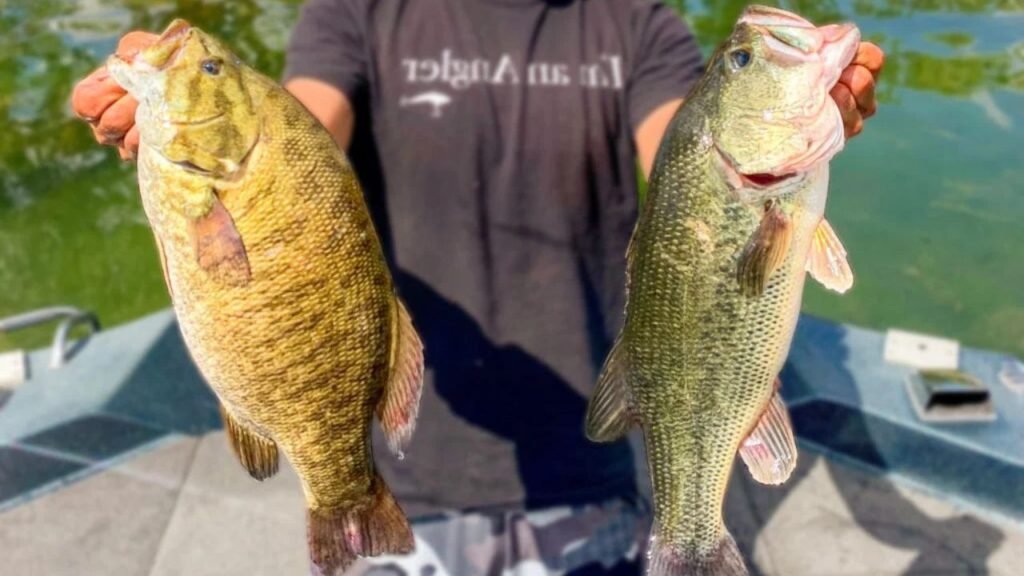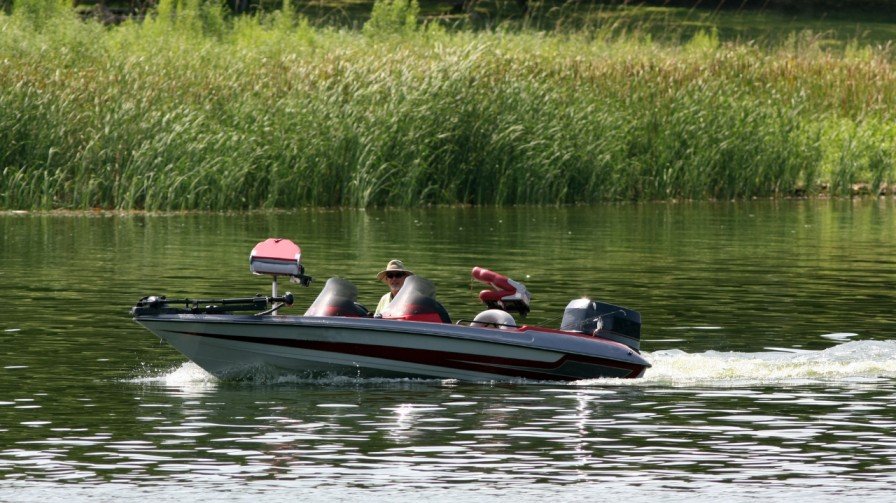Smallmouth bass and largemouth bass differ mainly in habitat preference and physical characteristics. Smallmouth bass prefer rocky areas, while largemouth bass thrive in weedy, warmer waters.
Smallmouth and largemouth bass are popular sport fish found in North America. Anglers often seek them for their fighting spirit and challenging catches. Smallmouth bass are generally found in clear, rocky lakes and rivers. They have a bronze hue and a smaller mouth that extends only to the middle of the eye.
Largemouth bass, on the other hand, prefer warmer, murky waters with plenty of vegetation. They are typically greenish with a larger mouth extending beyond the eyes. Understanding these differences helps anglers select the best fishing strategies and locations for each type.

Credit: www.fieldandstream.com
Physical Traits
Smallmouth and Largemouth Bass are popular freshwater fish in North America. They are loved by anglers for their fighting spirit. Although they share some similarities, their physical traits set them apart. This section explores the differences in their body shape and color patterns.
Body Shape
The body shape is a key difference between Smallmouth and Largemouth Bass. Understanding their shape helps you identify them easily.
- Smallmouth Bass: They have a more streamlined body. Their bodies are more torpedo-shaped. This shape helps them swim fast in rivers and streams.
- Largemouth Bass: They have a bulkier body. Their bodies are deeper and thicker. They are often found in calm waters like lakes and ponds.
Here’s a table summarizing their body shape traits:
| Trait | Smallmouth Bass | Largemouth Bass |
|---|---|---|
| Body Shape | Streamlined, torpedo-shaped | Bulkier, deeper |
| Habitat | Rivers, streams | Lakes, ponds |
Color Patterns
The color patterns of Smallmouth and Largemouth Bass also differ. These patterns help camouflage them in their habitats.
- Smallmouth Bass: They have a bronze or brownish color. Their sides have vertical bars or lines. These bars help them blend into rocky or sandy bottoms.
- Largemouth Bass: They are greenish with a white belly. They have a horizontal stripe along their sides. This stripe helps them blend into vegetation and muddy waters.
Here’s a table summarizing their color patterns:
| Trait | Smallmouth Bass | Largemouth Bass |
|---|---|---|
| Main Color | Bronze, brownish | Greenish, white belly |
| Markings | Vertical bars or lines | Horizontal stripe |
Understanding these physical traits helps you distinguish between these two species. This knowledge enhances your fishing experience and appreciation of these remarkable fish.
Habitat Preferences
Smallmouth and largemouth bass are popular targets for anglers. Understanding their habitat preferences is key to successful fishing. Both species have distinct preferences for water types and depths, making them unique in their own right.
Water Types
Smallmouth bass and largemouth bass prefer different water types. These differences influence where anglers can find them.
Smallmouth bass thrive in clear, cool waters. They are often found in rocky rivers and streams. Smallmouth bass also inhabit lakes with sandy or gravel bottoms. They enjoy flowing water and are often found near underwater structures like rocks and logs.
Largemouth bass prefer warmer, murkier waters. They are commonly found in ponds, lakes, and reservoirs. Largemouth bass love areas with lots of vegetation. They are often found near lily pads, weeds, and submerged trees. Unlike smallmouth bass, largemouth bass can tolerate low oxygen levels.
Here is a quick comparison of their water type preferences:
| Bass Type | Preferred Water Type |
|---|---|
| Smallmouth Bass | Clear, cool waters with rocky or sandy bottoms |
| Largemouth Bass | Warm, murky waters with lots of vegetation |
Preferred Depths
The preferred depths of smallmouth and largemouth bass vary significantly. These preferences can affect how anglers set up their gear.
Smallmouth bass generally prefer deeper waters. During the summer, they are often found at depths of 10 to 20 feet. In spring and fall, they move to shallower waters. Smallmouth bass love to stay near drop-offs and ledges.
Largemouth bass tend to stay in shallower waters. They are usually found at depths of 5 to 12 feet. In warmer months, they may move even shallower, sometimes just a few feet deep. Largemouth bass often stay near cover, such as submerged logs or weed beds.
Here’s a quick overview of their preferred depths:
| Bass Type | Preferred Depths |
|---|---|
| Smallmouth Bass | 10 to 20 feet in summer, shallower in spring and fall |
| Largemouth Bass | 5 to 12 feet, sometimes shallower in warm months |
Feeding Habits
Smallmouth and Largemouth Bass are two of the most popular game fish among anglers. Understanding their feeding habits can help anglers target these fish more effectively. This section explores the diet differences and hunting techniques of Smallmouth and Largemouth Bass.
Diet Differences
Smallmouth Bass have a diverse diet. They prefer crayfish, insects, and small fish. They also eat aquatic invertebrates and small amphibians. Smallmouth Bass are opportunistic feeders. They adapt their diet based on availability.
Largemouth Bass have a varied diet too. Their primary prey includes fish, frogs, and crayfish. They also consume small birds and mammals if the opportunity arises. Largemouth Bass are more likely to eat larger prey compared to Smallmouth Bass.
| Food Source | Smallmouth Bass | Largemouth Bass |
|---|---|---|
| Crayfish | ✔️ | ✔️ |
| Insects | ✔️ | ✔️ |
| Small Fish | ✔️ | ✔️ |
| Frogs | ✔️ | ✔️ |
| Birds | ✔️ | |
| Small Mammals | ✔️ |
Hunting Techniques
Smallmouth Bass are known for their aggressive hunting techniques. They prefer clear, rocky waters. They use their keen eyesight to spot prey. Smallmouth Bass often hunt in packs. This pack behavior makes them more effective hunters.
Largemouth Bass use ambush tactics. They prefer murky waters with lots of cover. They hide in vegetation or under structures. Largemouth Bass wait for prey to come close. Then, they strike quickly with powerful bursts of speed.
- Smallmouth Bass:
- Hunt in packs
- Prefer clear, rocky waters
- Use keen eyesight
- Largemouth Bass:
- Use ambush tactics
- Prefer murky waters with cover
- Strike with speed
Understanding these differences in feeding habits can enhance your fishing strategy. Knowing what they eat and how they hunt is key to successful bass fishing.
Behavioral Patterns
Understanding the behavioral patterns of Smallmouth and Largemouth Bass can significantly enhance your fishing experience. These patterns dictate how they interact with their environment, their reactions to threats, and their feeding habits. By observing these patterns, you can better predict their movements and improve your chances of a successful catch.
Schooling Behavior
Smallmouth Bass are known for their tendency to school more frequently than Largemouth Bass. They often form groups, especially during certain times of the year. This schooling behavior aids in their protection and increases their hunting efficiency.
- Smallmouth Bass often school in deeper waters.
- Largemouth Bass are more solitary, preferring shallow, vegetated areas.
Smallmouth Bass schools can consist of dozens of fish, making them easier to locate if you find one. They typically form these schools in rocky areas or near underwater structures. This behavior also helps them ward off predators.
On the other hand, Largemouth Bass exhibit less schooling behavior. They prefer to hunt alone or in small groups. They often hide in thick vegetation or around structures, waiting to ambush their prey. This solitary nature makes them more challenging to locate.
Aggression Levels
The aggression levels of Smallmouth and Largemouth Bass differ significantly. Smallmouth Bass are generally more aggressive. They are known for their fierce fighting spirit and will put up a tough fight when hooked. This aggression makes them popular among sport fishermen.
Largemouth Bass are less aggressive but still offer a challenging catch. They are known for their strong initial strike. Once hooked, they will often leap out of the water in an attempt to free themselves. This behavior can be exciting for anglers.
In terms of territorial aggression, Smallmouth Bass are more territorial. They will defend their area more aggressively against intruders. This behavior is especially noticeable during spawning season.
Largemouth Bass exhibit territorial behavior, but it is less pronounced. They are more likely to flee than to fight if threatened. Understanding these aggression levels can help you choose the right bait and techniques to use.
Fishing Techniques
Fishing for bass is an exciting and rewarding experience. Whether you are targeting smallmouth or largemouth bass, each species has unique behaviors and preferences. Understanding the best fishing techniques for both types will help you catch more fish and enjoy your time on the water.
Best Baits
Choosing the right bait is crucial for successful bass fishing. For smallmouth bass, the following baits are highly effective:
- Crankbaits: These mimic the movement of small fish and attract aggressive smallmouth.
- Jigs: Especially effective when tipped with soft plastics or live bait.
- Soft Plastics: Worms, grubs, and creature baits that imitate prey smallmouth love.
For largemouth bass, consider these baits:
- Spinnerbaits: The flashing and vibration attract largemouth from a distance.
- Topwater Lures: Ideal for early morning or late evening, creating surface commotion.
- Plastic Worms: Versatile and effective in various conditions, especially when rigged Texas or Carolina style.
Both species respond well to live bait. Minnows, crayfish, and nightcrawlers are excellent choices. Knowing their preferences will increase your chances of a successful catch.
Fishing Seasons
Understanding the best seasons for fishing smallmouth and largemouth bass can significantly improve your success rate. Smallmouth bass are most active during:
- Spring: Pre-spawn and spawning periods, when they move to shallow waters.
- Summer: Early morning and late evening, when they feed actively.
- Fall: As they prepare for winter, smallmouth bass feed heavily.
Largemouth bass have slightly different seasonal patterns:
- Spring: Spawning season, best time to find them in shallow waters.
- Summer: Seek cooler, deeper water during the heat of the day.
- Fall: Active feeding as temperatures drop, making them easier to catch.
Winter fishing for both species is more challenging. They become less active and move to deeper waters. Focus on slow presentations and patience during the colder months.
Size Comparison
Smallmouth and largemouth bass are two popular freshwater fish. Anglers often debate which is more thrilling to catch. One key difference is their size. This blog post will explore the size comparison between smallmouth and largemouth bass.
Average Lengths
Smallmouth and largemouth bass differ significantly in length. Smallmouth bass generally measure 14 to 18 inches long. They can sometimes reach up to 20 inches, but this is rare. Largemouth bass, on the other hand, are typically 16 to 24 inches in length. Some can even grow up to 30 inches in exceptional conditions.
Here is a quick comparison table:
| Fish Type | Average Length (inches) |
|---|---|
| Smallmouth Bass | 14 – 18 |
| Largemouth Bass | 16 – 24 |
Largemouth bass are generally longer than smallmouth bass. This size difference makes them a favorite among anglers. They offer more of a challenge and greater excitement. When fishing, keep these length differences in mind. It helps in identifying which type of bass you have caught.
Weight Range
Weight is another key factor in distinguishing these two fish. Smallmouth bass usually weigh between 1 to 4 pounds. Rare catches can weigh up to 6 pounds. Largemouth bass, however, often weigh 2 to 8 pounds. Exceptional largemouth bass can even exceed 10 pounds. This makes largemouth bass not only longer but also heavier.
Here is a comparison table for better understanding:
| Fish Type | Weight Range (pounds) |
|---|---|
| Smallmouth Bass | 1 – 4 |
| Largemouth Bass | 2 – 8 |
Largemouth bass are more likely to offer a heavier catch. This makes them a preferred target for trophy hunters. The weight difference is significant when planning your fishing trip. Knowing the typical weight ranges can enhance your fishing experience. It also helps in choosing the right gear.
Recreational Value
Smallmouth and Largemouth Bass are two of the most sought-after fish by anglers. Their popularity stems not only from their size and fight but also from the sheer joy and satisfaction they bring to fishing enthusiasts. Let’s dive into the recreational value of these two incredible species.
Sport Fishing Popularity
Both Smallmouth and Largemouth Bass are immensely popular among sport fishers. Each species offers a unique challenge and thrill.
Smallmouth Bass are known for their aggressive fight. They often leap out of the water, making them a favorite for those who enjoy a dynamic fishing experience. Largemouth Bass, on the other hand, are loved for their size and strength. They can grow to impressive lengths, providing a formidable challenge for any angler.
Fishing tournaments frequently feature both types of bass. These events draw large crowds and offer significant prizes. Bassmaster and FLW are two of the most prominent organizations hosting such tournaments.
Here’s a quick comparison of their sport fishing popularity:
| Aspect | Smallmouth Bass | Largemouth Bass |
|---|---|---|
| Fight | Aggressive and acrobatic | Strong and powerful |
| Size | Smaller, but feisty | Larger, more challenging |
| Tournaments | Popular, but fewer | Highly popular and frequent |
Catch And Release Practices
Catch and release is a common practice among bass fishers. This method helps maintain fish populations and ensures sustainable fishing.
Smallmouth Bass are often caught and released because they are less abundant in some areas. Anglers use special hooks to minimize harm. They also handle the fish gently and release them quickly.
Largemouth Bass are more abundant, but catch and release is still widely practiced. This is due to their popularity and the desire to keep fishing spots stocked.
Best practices for catch and release include:
- Using barbless hooks
- Handling the fish with wet hands
- Releasing the fish as quickly as possible
- Avoiding fishing during spawning season
These practices help ensure that the fish survive and continue to thrive, providing recreational value for future generations.

Credit: bassonline.com
Conservation Status
Smallmouth and Largemouth Bass are two popular fish among anglers. Both species play essential roles in their ecosystems. Understanding their conservation status is crucial for maintaining healthy populations. This post will explore the population trends and conservation efforts for both species.
Population Trends
Smallmouth and Largemouth Bass populations have experienced different trends over the years. These trends provide insights into the health and stability of their respective ecosystems.
Smallmouth Bass:
- Smallmouth Bass populations have fluctuated in various regions.
- Factors such as habitat loss, pollution, and overfishing contribute to these fluctuations.
- In some areas, Smallmouth Bass numbers have declined significantly.
Largemouth Bass:
- Largemouth Bass populations are generally more stable.
- They adapt well to various environments, including ponds, lakes, and rivers.
- Despite this, certain regions report slight declines due to similar factors affecting Smallmouth Bass.
Comparing the population trends of these species highlights the need for targeted conservation strategies.
Conservation Efforts
Efforts to conserve Smallmouth and Largemouth Bass focus on protecting their habitats and managing fishing practices. These efforts are vital for sustaining their populations.
Key Conservation Strategies:
- Habitat Restoration: Restoring rivers and lakes to their natural states helps both species thrive.
- Pollution Control: Reducing pollutants in water bodies ensures cleaner habitats.
- Fishing Regulations: Implementing size and bag limits prevents overfishing.
- Stocking Programs: Releasing hatchery-raised fish into the wild supports population growth.
Organizations and government agencies play crucial roles in these efforts. Partnerships with local communities also enhance conservation success.
In summary, ongoing conservation efforts aim to ensure the long-term survival of Smallmouth and Largemouth Bass. Effective management practices are essential for maintaining their populations and supporting healthy ecosystems.

Credit: fishingbooker.com
Understanding the differences between smallmouth and largemouth bass can enhance your fishing experience. Whether targeting smallmouth’s feisty nature or largemouth’s size, both offer unique challenges. Equip yourself with the right knowledge and gear. Happy fishing!
FAQs:
What Is The Difference Between Smallmouth And Largemouth Bass?
Smallmouth bass have a smaller mouth and are brownish with vertical stripes. Largemouth bass have a larger mouth and are green with a horizontal stripe.
Where Do Smallmouth Bass Live?
Smallmouth bass prefer clear, rocky waters like rivers and lakes. They thrive in cooler temperatures and strong currents.
What Do Largemouth Bass Eat?
Largemouth bass primarily eat smaller fish, crayfish, and insects. They can also consume frogs and small aquatic animals.
Which Bass Is Harder To Catch?
Smallmouth bass are generally harder to catch. They are more aggressive fighters and often found in difficult-to-reach habitats.



